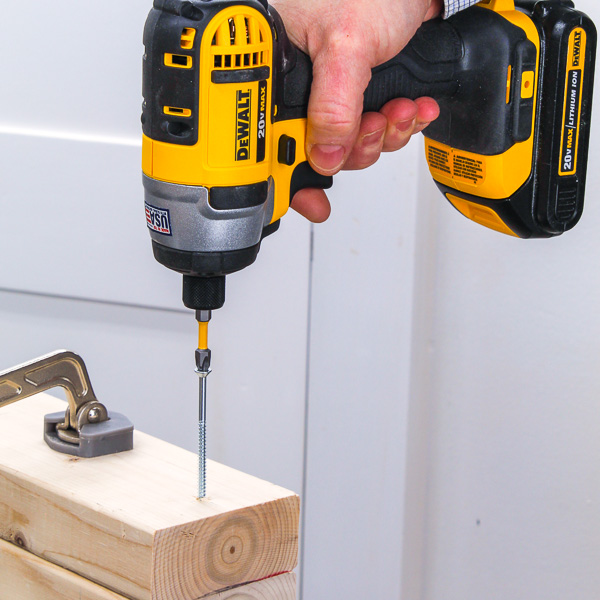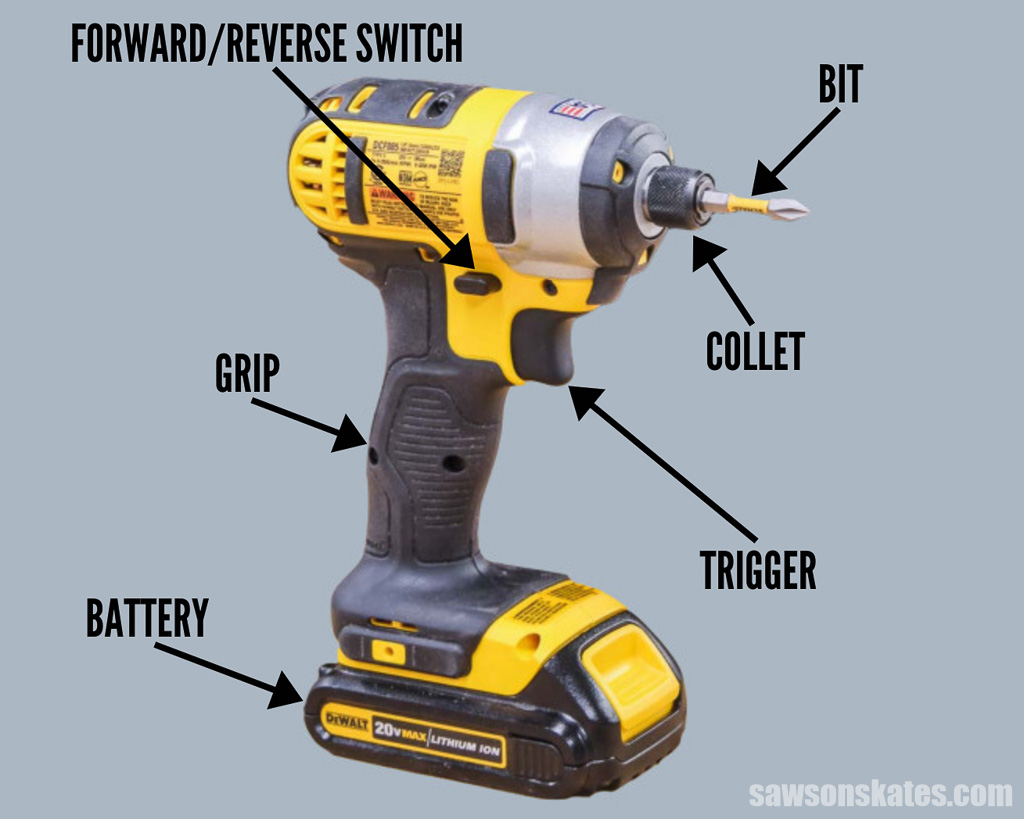Looking to find out if you can use an impact driver as a screwdriver? Well, you’ve come to the right place!
Picture this: you’ve got a project in mind, and you’re wondering if your trusty impact driver can double up as a screwdriver.
In this article, we’ll explore whether an impact driver can handle the tasks typically performed by a screwdriver. Let’s dive in!
Using an impact driver as a screwdriver is possible, but it may not be the best tool for the job. Impact drivers are designed for driving screws quickly and efficiently with high torque, whereas a screwdriver provides more control and precision. While an impact driver can work in a pinch, using a dedicated screwdriver will yield better results for delicate projects or when working with smaller screws.

Can You Use an Impact Driver as a Screwdriver?: Exploring the Possibilities
Impact drivers and screwdrivers are both essential tools in any DIY enthusiast or professional’s toolbox. While they serve similar purposes, there are distinct differences between the two. Impact drivers are known for their ability to deliver high torque and quick rotations, making them ideal for driving screws into various materials. On the other hand, screwdrivers are designed specifically for the task of driving screws. But, can you use an impact driver as a screwdriver? Let’s dive deep into this topic to understand the possibilities and limitations of using an impact driver in place of a traditional screwdriver.
Understanding the Impact Driver
An impact driver is a powerful, handheld tool that uses concussive blows to drive screws into different materials. It harnesses rotational force from the motor and then delivers rapid, short bursts of higher torque to the screw. This mechanism allows the impact driver to effortlessly drive screws into dense materials like hardwood without the need for excessive force from the user. Additionally, impact drivers often have hexagonal chucks that accept standard 1/4-inch hex bits, making them versatile for various screwing applications.
While impact drivers excel at driving screws, they may not be the best choice for delicate or precise work. The concussive force of the impacts can sometimes cause damage or strip screws if not used with caution. Additionally, their high torque and rapid rotations may lead to overdriving or overtightening screws, which can compromise the integrity of the material being screwed into. Considering these limitations, it is essential to know when and how to use an impact driver effectively.
Impact Driver vs. Screwdriver: The Benefits and Drawbacks
The Benefits of Using an Impact Driver as a Screwdriver
1. Increased Speed and Efficiency: Impact drivers deliver rapid bursts of torque, allowing you to drive screws quickly and efficiently. This feature is particularly beneficial when you have numerous screws to drive or are working on large-scale projects.
2. Versatility: Impact drivers can accept a wide range of 1/4-inch hex bits, making them versatile for various screwing applications. This versatility eliminates the need for carrying multiple screwdrivers or bits, saving you time and effort.
3. Power and Torque: Impact drivers are incredibly powerful tools and can produce high levels of torque, surpassing what traditional screwdrivers can achieve. This makes them ideal for driving screws into tough materials like hardwood or concrete.
The Drawbacks of Using an Impact Driver as a Screwdriver
1. Lack of Finesse: Impact drivers prioritize speed and power over precision, making them less suitable for delicate or intricate work. Their rapid bursts of torque can lead to overtightening or stripping of screws if not used with caution.
2. Size and Weight: Impact drivers are generally larger and heavier than screwdrivers. While this can provide additional grip and stability for some users, it can also make them cumbersome when working in tight or confined spaces.
3. Noise and Vibration: Impact drivers are noisier and vibrate more than traditional screwdrivers. Prolonged use can lead to fatigue and discomfort, making them less desirable for projects that require extended periods of screwing.
It’s important to note that while an impact driver can be used as a screwdriver, it’s not a direct replacement for a traditional screwdriver. Each tool has its own set of advantages and disadvantages, and understanding their capabilities is crucial for selecting the right tool for the task at hand.
Tips for Using an Impact Driver as a Screwdriver
While using an impact driver as a screwdriver, follow these tips to ensure efficient and effective results:
1. Choose the Right Bit
Ensure that you select the appropriate 1/4-inch hex bit for the screw you’re using. Using the wrong bit may result in a poor fit, which can lead to slipping or stripping of the screw head.
2. Adjust the Impact Driver Settings
Most impact drivers come with adjustable torque settings. For driving screws, lower torque settings are recommended, especially when working with delicate materials or smaller screws. Adjust the settings to suit the requirements of your project.
3. Apply Gentle Pressure
Avoid applying excessive force while using an impact driver. The high torque and quick rotations of the impact driver are usually sufficient to drive the screw into the material comfortably. Keenly monitor the progress and ensure the screw is driven flush without overdriving.
4. Practice and Familiarize Yourself
Using an impact driver as a screwdriver may take some practice to master. Familiarize yourself with the tool’s operation, and experiment on scrap materials before working on your actual project. This will help you get a better understanding of the impact driver’s capabilities and limitations.
5. Use Proper Personal Protective Equipment (PPE)
When operating any power tool, including impact drivers, it is essential to prioritize safety. Wear safety goggles to protect your eyes from any flying debris, and use ear protection to reduce the impact of the tool’s noise and vibrations.
Exploring the World of Impact Drivers
Impact drivers are versatile and powerful tools, and while they can be used as a substitute for screwdrivers in certain situations, they are not a direct replacement. Consider the advantages and limitations discussed in this article when deciding whether to use an impact driver as a screwdriver or invest in a dedicated screwdriver. By understanding the capabilities of each tool and following the recommended tips, you can make informed decisions and ensure successful and efficient results in your DIY projects. So go ahead and explore the world of impact drivers, but always remember to prioritize safety and choose the right tool for the task at hand.
Key Takeaways: Can You Use an Impact Driver as a Screwdriver?
- Yes, an impact driver can be used as a screwdriver.
- Impact drivers are specifically designed for fastening screws and bolts.
- They provide high torque and rapid rotational force, making them efficient for driving screws.
- However, impact drivers may not be suitable for delicate or precision applications.
- Using the correct type of screwdriver for the job is important to avoid damage or stripping of screws.
Frequently Asked Questions
Here are some frequently asked questions related to using an impact driver as a screwdriver.
1. Can I use an impact driver instead of a screwdriver?
While an impact driver can be used to drive screws, it is not a suitable replacement for a screwdriver in every situation. Impact drivers are designed to deliver high torque and are great for heavy-duty tasks. However, they may be too powerful for delicate tasks or when working with softer materials like wood. Additionally, impact drivers do not provide the same level of control as a screwdriver, making them less precise in certain applications. Therefore, it is recommended to use a screwdriver when precision and control are crucial to the task at hand.
2. What are the advantages of using an impact driver over a screwdriver?
Using an impact driver instead of a screwdriver offers several advantages. Firstly, an impact driver can deliver a higher level of torque, making it easier to drive screws into tough materials like metal or concrete. Impact drivers are also more efficient and can quickly drive screws without the need for as much manual effort. Additionally, impact drivers often have features like variable speed settings or built-in LED lights that can enhance productivity and accuracy when working on different projects. So, if you have heavy-duty tasks or lots of screws to drive, an impact driver can be a valuable tool to have in your toolbox.
3. Are there any downsides to using an impact driver as a screwdriver?
While impact drivers are powerful and efficient tools, they may not be suitable for all screwdriving applications. The high torque of an impact driver can cause damage to delicate materials or strip screws if not used with caution. Impact drivers also lack the precision and control of a screwdriver, making them less ideal for tasks that require finesse or working with softer materials. Additionally, impact drivers are often noisier and bulkier than screwdrivers, which can be a consideration if you are working in tight spaces or need a quieter environment. Therefore, it is important to assess the specific task and materials before deciding whether to use an impact driver or a screwdriver.
4. Can I use an impact driver to remove screws?
Yes, an impact driver can be used to remove screws as well. The high torque and rotational force of the impact driver can help loosen stubborn or rusty screws, making them easier to remove. However, it is important to use the correct bit and adjust the torque settings to avoid damaging the screw or the surrounding material. Additionally, it is recommended to practice control and technique to prevent over-tightening or accidentally stripping the screw. So, an impact driver can be a helpful tool for removing screws, especially when dealing with tougher or stuck fasteners.
5. Are there any safety precautions to consider when using an impact driver as a screwdriver?
Yes, there are a few safety precautions to consider when using an impact driver as a screwdriver. Firstly, always wear appropriate safety gear such as safety glasses or goggles to protect your eyes from flying debris. Additionally, ensure you have a secure grip on the tool to maintain control while driving screws. It is also important to use the correct bit for the task and adjust the torque settings appropriately to prevent any damage or accidents. Lastly, be mindful of the noise levels, especially if you are working in an enclosed space or around others. Following these safety precautions will help ensure a safe and successful use of an impact driver as a screwdriver.

When To Use an Impact Driver VS Drill: The ULTIMATE Guide
Summary
An impact driver can be used as a screwdriver, but it’s important to consider a few things. First, impact drivers are more powerful than regular screwdrivers, so they can easily damage delicate screws or materials. Second, impact drivers are designed for quick and repetitive drilling or driving tasks, so they may not provide the precision and control needed for certain projects. It’s best to use an impact driver for heavy-duty work and stick to a regular screwdriver for more delicate tasks.
In conclusion, an impact driver can be a handy tool for driving screws, but it’s not always the ideal choice. Understanding its power and limitations will help you decide when to use it and when to opt for a regular screwdriver. Remember to choose the right tool for the job to ensure successful and safe DIY projects.
